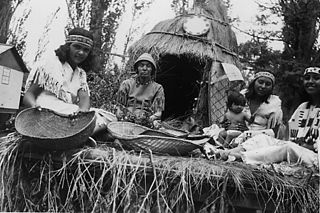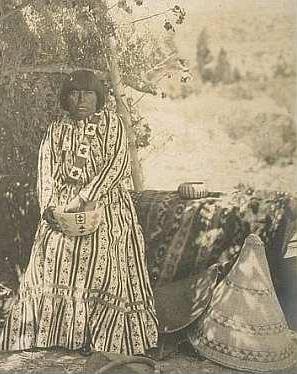
Owens Valley is an arid valley of the Owens River in eastern California in the United States. It is located to the east of the Sierra Nevada, west of the White Mountains and Inyo Mountains, and is split between the Great Basin Desert and the Mojave Desert. The mountain peaks on the West side reach above 14,000 feet (4,300 m) in elevation, while the floor of the Owens Valley is about 4,000 feet (1,200 m), making the valley the deepest in the United States. The Sierra Nevada casts the valley in a rain shadow, which makes Owens Valley "the Land of Little Rain". The bed of Owens Lake, now a predominantly dry endorheic alkali flat, sits on the southern end of the valley.

The Indigenous peoples of the Great Basin are Native Americans of the northern Great Basin, Snake River Plain, and upper Colorado River basin. The "Great Basin" is a cultural classification of indigenous peoples of the Americas and a cultural region located between the Rocky Mountains and the Sierra Nevada, in what is now Nevada, and parts of Oregon, California, Idaho, Wyoming, and Utah. The Great Basin region at the time of European contact was ~400,000 sq mi (1,000,000 km2). There is very little precipitation in the Great Basin area which affects the lifestyles and cultures of the inhabitants.
Timbisha (Tümpisa) or Panamint is the language of the Native American people who have inhabited the region in and around Death Valley, California, and the southern Owens Valley since late prehistoric times. There are a few elderly individuals who can speak the language in California and Nevada, but none are monolingual, and all use English regularly in their daily lives. Until the late 20th century, the people called themselves and their language "Shoshone." The tribe then achieved federal recognition under the name Death Valley Timbisha Shoshone Band of California. This is an Anglicized spelling of the native name of Death Valley, tümpisa, pronounced, which means "rock paint" and refers to the rich sources of red ochre in the valley. Timbisha is also the language of the so-called "Shoshone" groups at Bishop, Big Pine, Darwin, Independence, and Lone Pine communities in California and the Beatty community in Nevada. It was also the language spoken at the former Indian Ranch reservation in Panamint Valley.

Numic is the northernmost branch of the Uto-Aztecan language family. It includes seven languages spoken by Native American peoples traditionally living in the Great Basin, Colorado River basin, Snake River basin, and southern Great Plains. The word Numic comes from the cognate word in all Numic languages for “person”, which reconstructs to Proto-Numic as. For example, in the three Central Numic languages and the two Western Numic languages it is. In Kawaiisu it is and in Colorado River, and.

The Mono are a Native American people who traditionally live in the central Sierra Nevada, the Eastern Sierra, the Mono Basin, and adjacent areas of the Great Basin. They are often grouped under the historical label "Paiute" together with the Northern Paiute and Southern Paiute – but these three groups, although related within the Numic group of Uto-Aztecan languages, do not form a single, unique, unified group of Great Basin tribes.
The Big Pine Band of Owens Valley Paiute Shoshone Indians of the Big Pine Reservation are a federally recognized tribe of Mono and Timbisha Indians in California.
The Timbisha are a Native American tribe federally recognized as the Death Valley Timbisha Shoshone Band of California. They are known as the Timbisha Shoshone Tribe and are located in south central California, near the Nevada border. As of the 2010 Census the population of the Village was 124. The older members still speak the ancestral language, also called Timbisha.

The Cold Springs Rancheria of Mono Indians of California is a federally recognized tribe of Mono Native Americans. Cold Springs Rancheria is the tribe's reservation, which is located in Fresno County, California. As of the 2010 census the population was 184.

The Bridgeport Indian Colony of California, formerly known as the "Bridgeport Paiute Indian Colony of California", is a federally recognized tribe of Northern Paiute Indians in Mono County, California, United States.

The Fort Bidwell Indian Community of the Fort Bidwell Reservation of California is a federally recognized tribe of Northern Paiute Indians in Modoc County in the northeast corner of California.
The Lovelock Paiute Tribe of the Lovelock Indian Colony is a federally recognized tribe of Northern Paiute Indians in Pershing County, Nevada.

The Bishop Paiute Tribe, formerly known as the Paiute-Shoshone Indians of the Bishop Community of the Bishop Colony is a federally recognized tribe of Mono and Timbisha Indians of the Owens Valley, in Inyo County of eastern California. As of 2022, the United States census showed the Bishop Paiute Tribe's population at 1,914.
The Paiute-Shoshone Tribe of the Fallon Reservation and Colony is a federally recognized tribe of Northern Paiute and Western Shoshone Indians in Churchill County, Nevada. Their autonym is Toi Ticutta meaning "Cattail Eaters."

The Summit Lake Paiute Tribe of Nevada is a federally recognized tribe of Northern Paiute Indians in northwest Nevada. Their autonym in their language is Agai Panina Ticutta, meaning "Fish Lake Eaters." They are traditionally known as the "Fish Eaters."

The XL Ranch is an Indian reservation located in Modoc County, north of Burney, California.
The Utu Utu Gwaitu Paiute Tribe of the Benton Paiute Reservation, also known as the Benton Paiute Tribe, is a federally recognized Great Basin tribe in Mono County, California.

The Kucadɨkadɨ are a band of Eastern Mono Northern Paiute people who live near Mono Lake in Mono County, California. They are the southernmost band of Northern Paiute.
The Fort Independence Indian Community of Paiute Indians of the Fort Independence Reservation is a federally recognized tribe of Mono and Timbisha in the Owens Valley, in Inyo County, eastern California. As of the 2010 census the population was 93.

The Fort McDermitt Paiute and Shoshone Tribe is a federally recognized tribe of Northern Paiute and Western Shoshone peoples, whose reservation Fort McDermitt Paiute and Shoshone Tribes of the Fort McDermitt Indian Reservation spans the Nevada and Oregon border next to Idaho. The reservation has 16,354 acres (6,618 ha) in Nevada and 19,000 acres (7,700 ha) in Oregon.













